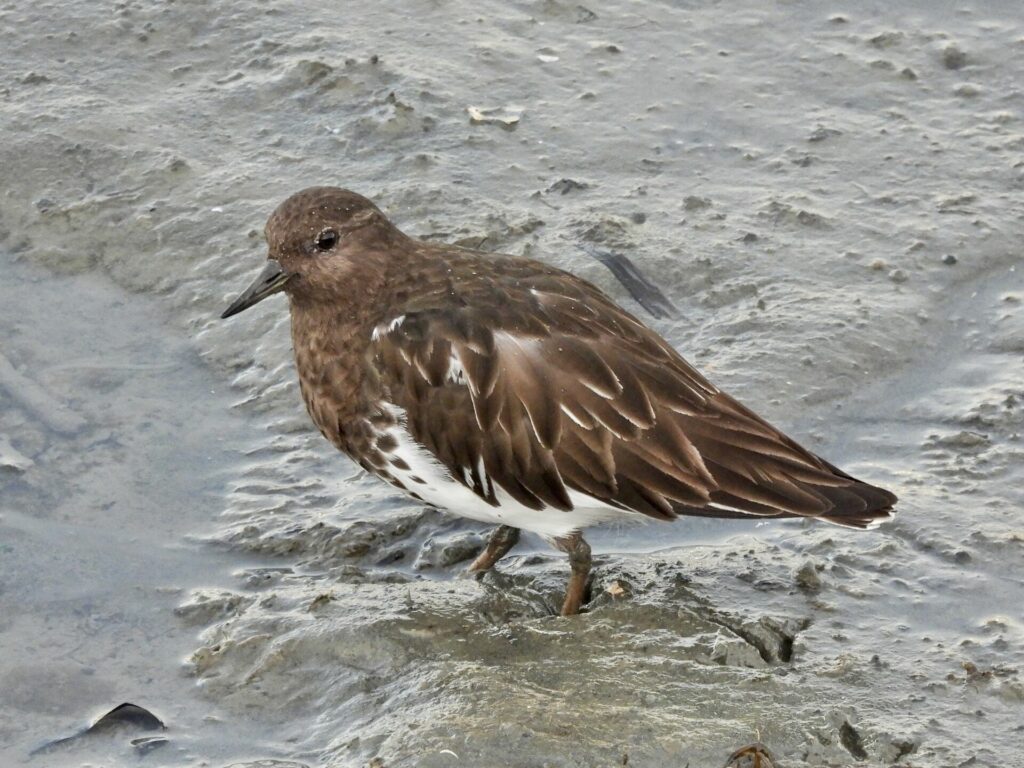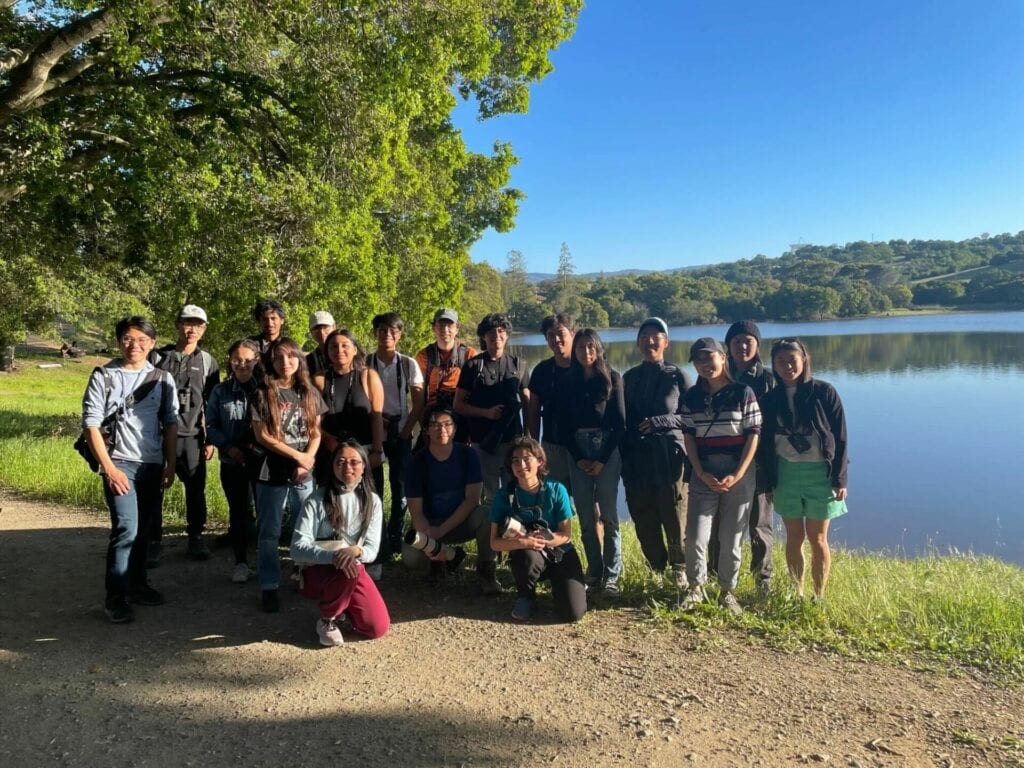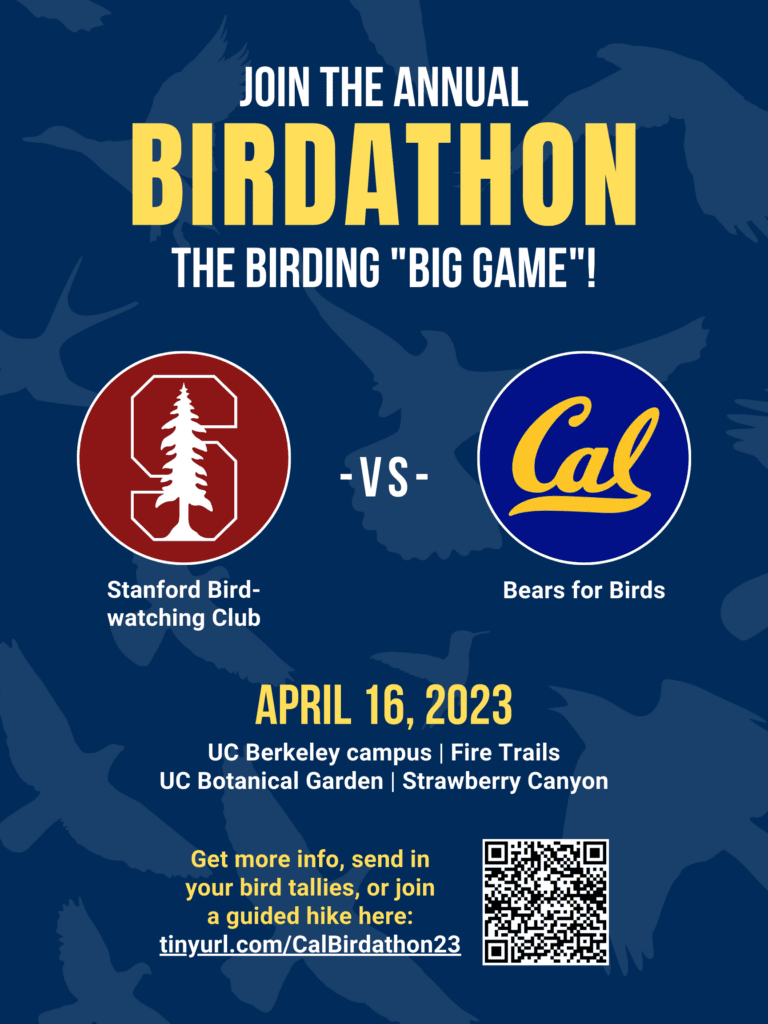The Berkeley-Stanford Birdathon
By Sierra Glassman
Competition has been ingrained in birding culture for a long time. Surprisingly, only one birding competition has ever occurred between Stanford and Berkeley, back in 2014. That is until this past spring, when the Bears for Birds and Stanford Birdwatching Club matched up once again.
Established two years ago, Bears for Birds is UC Berkeley’s undergraduate club for birdwatchers. This spring, we met twice a week for indoor meetings and birding excursions. Since January, an idea had been brewing to organize a Birdathon with the Stanford Birdwatching Club. After discovering Berkeley lost the last Birdathon in 2014 (covered in this article), we could not let it stand and quickly contacted the Stanford Birdwatching Club. Their leadership team was receptive, and proposed we do an “exchange program” leading up to the big day, where we would visit birding spots together near each other’s campuses.
During the first exchange, the Stanford Birdwatching Club came to Berkeley. We took them to Cesar Chavez Park and Vollmer Peak in Tilden Regional Park.The ecosystem was unbalanced, with Bears outnumbering Redwood Trees 14-3. Though we outnumbered Stanford, we couldn’t help but admire their phenomenal birding skills.
“I remember (Adam Burnett) pointed at three dots that were barely visible through binos and called out the species (Bald Eagles),” Greg Salazar, a member of Bears for Birds, said.””As they got closer I saw he was right and it was really cool for me to be with someone who was such an expert.”
After encountering a flock of White-throated Swifts and a Cooper’s Hawk we reached the peak overlooking the bay, where we took group photos.

Next, we birded along the northeast edge of Cesar Chavez Park, looking for Burrowing Owls, without success. I talked with Maya Xu about recording falcons nesting on Stanford’s tower similarly to the Berkeley Campanile falcons (she was interviewed about the Hoover Tower falcons here). Before we knew it, the sun was setting, and we sat cross-legged on the fake grass next to the parking lot, eating pizza and sharing our favorite parts of the day.

A month later, it was the Bears’ turn to enter enemy territory. We joined Stanford at the Palo Alto Baylands, where we immediately sighted an elusive Ridgeway’s Rail. The marsh was teeming with bird life. Sparrows sang from the bushes and peeps ran across the mud. Up on an electric tower was a pile of sticks, a Common Raven nest. The photographers among us challenged each other to get shots of the Cliff Swallows darting under a floating dock.

After walking the Baylands, we paused for some snacks before birding Lake Lagunita. Several duck species dotted the water, including a Mallard family with newly-hatched young. Bushtits tittered and hopped around their nest in a thin oak sapling.

In the weeks that followed, we worked out the details for the day of the Birdathon over email. Within a 24-hour window on April 16, Stanford would record all eBird-ed species reported on their campus, and Berkeley would use a Google Form where participants could record their species list or link their eBird checklists. The week leading up to the event, we put up posters advertising the Birdathon around Berkeley campus to alert fellow Bears of our upcoming competition.

On the big day itself, our members could either bird independently or tag along on officer-led trips, held at various locations during each of the following time slots: dawn, morning, afternoon, and evening. I woke up at 5am and recorded what I heard from the dawn chorus. Then, I took a dawn shift on campus, followed by a successful morning at the Botanical Gardens, and an evening walking the fire trails. According to my phone, I walked 38,000 steps by the end of the day.
Nathalie Orellana and I saw a Red-shouldered Hawk de-feathering an Acorn Woodpecker on our dawn expedition. Allen’s Hummingbirds were seen at the UC Botanical Garden. The greatest sighting of the day was by Kristina Twaalfhoven, Nathalie Orellana, and Eli McAmis who encountered a Great Horned Owl up-close near the Clark Kerr dorms. By midnight, 24 Bears and Bear-affiliates had submitted their checklists to the form.
A few days later, the tallies were out. Berkeley totaled 65 species, beating our previous score of 63 from 2014. But Stanford counted 91 species.
Though Berkeley lost, we had fun participating and got to reflect on what we got out of birding.
“I learned that I really don’t do birding for the props or for points, or to achieve any sort of goal. For me, it’s just about being outdoors and enjoying things at exactly my own pace, and I like that a lot,” said Greg Salazar. “Some of my favorite times birding have been when I stop and just really take joy in a sparrow or a junco or something ‘mundane’.”
A study of college students showed that “Students who bird-watched had higher scores in those categories selected as having more concern for another living thing and lower scores in the categories that measured less concern than those who did not bird-watch” (Yore and Boyer, 1997). By welcoming a variety of students who are interested in birds and have yet to determine their careers, Bears for Birds provides an opportunity to expose future conservationists to birding.
“Bird club helped me meet fellow students who care about birds and who have diverse experience levels,” said Jonathan Lee, an urban studies major. ”Helping others to grow is really encouraging.”
Campus bird club activities, like the Birdathon, may influence how our members navigate their future careers, promoting greater attention to bird conservation.
A project we started this spring that helped us prepare for Birdathon was the Berkeley Avian Biodiversity Survey. Members practiced identifying campus birds while contributing to a dataset. The first campus surveys occurred in 1913, then in 1938–39 and 2006–07. The surveys involve walking a transect and annotating the species, amount of individuals, and environmental conditions in a google spreadsheet. After this spring’s success, we will try to build the surveys into a consistent long-term dataset of bird biodiversity on campus. We are welcoming volunteers to survey alongside Berkeley students; all birders interested in participating can contact me (sierraruyi@berkeley.edu).
We also plan to have another Birdathon next year. Our officers agree with the scoring strategy Stanford suggested in their trip report: comparing the amount of species above the baseline biodiversity spotted on each of our campuses. We would measure baseline diversity for each campus by averaging the 2014 and 2023 species, “and whoever has the higher species total relative to that baseline [will] win.”
Ultimately, birding requires an appreciation for others’ perspectives. You have to understand a bird’s-eye view, how its environment and individuality intersect in order to appreciate its behavior, morphology, history, and being. And, you have to understand people in order to make a positive impact by birding and effectively communicate the importance of birds. Our Birdathon was much more than an extension of the age-old rivalry between Berkeley and Stanford; it was a way to exchange knowledge and positive experiences between communities that care about our environment.
Thank you to Nathalie Orellana, Kristina Twaalfhoven, and Jonathan Lee for helping to edit this piece.
References
DeBare, Ilana. “Cardinals trounce Bears in first ever birding Big Game.” Berkeleyside (2014) https://www.berkeleyside.org/2014/04/14/birding-bears-lose-to-cardinals.
Yore, Lola Boeck, and Stan Boyer. “College students’ attitudes towards living organisms: The influence of experience & knowledge.” The American Biology Teacher (1997): 558-563.
Bio
Sierra Glassman is a rising senior at UC Berkeley, majoring in Integrative Biology. She is an officer of Bears for Bird and is researching hummingbird behavior.
